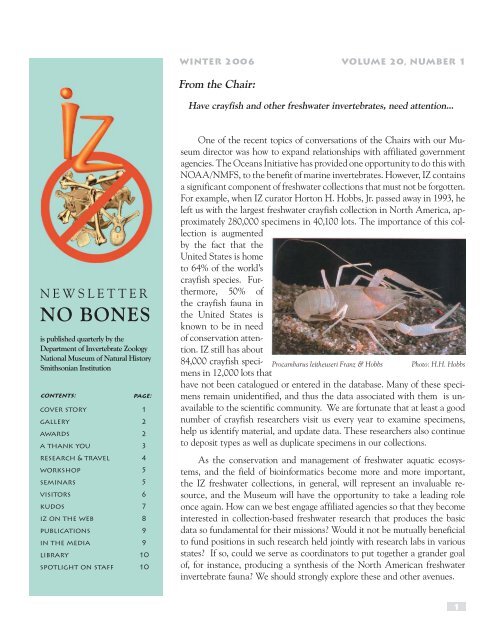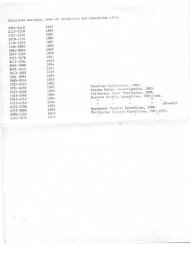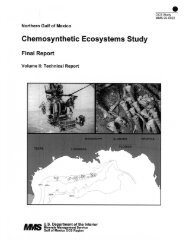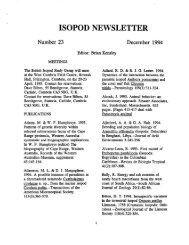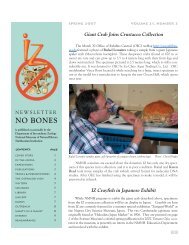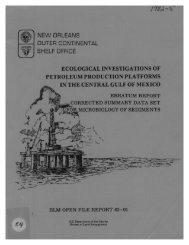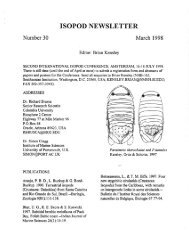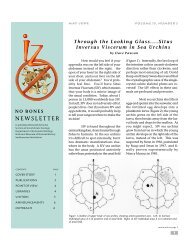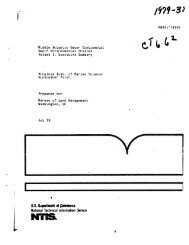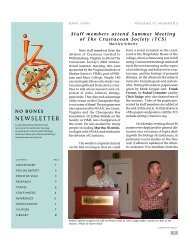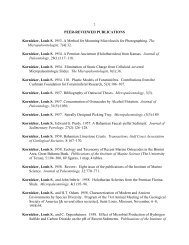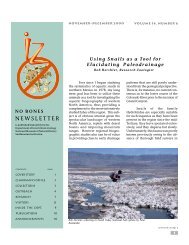Winter 2006 - Department of Invertebrate Zoology - Smithsonian ...
Winter 2006 - Department of Invertebrate Zoology - Smithsonian ...
Winter 2006 - Department of Invertebrate Zoology - Smithsonian ...
Create successful ePaper yourself
Turn your PDF publications into a flip-book with our unique Google optimized e-Paper software.
WINTER <strong>2006</strong><br />
VOLUME 20, NUMBER 1<br />
From the Chair:<br />
Have crayfish and other freshwater invertebrates, need attention...<br />
NEWSLETTER<br />
NO BONES<br />
is published quarterly by the<br />
<strong>Department</strong> <strong>of</strong> <strong>Invertebrate</strong> <strong>Zoology</strong><br />
National Museum <strong>of</strong> Natural History<br />
<strong>Smithsonian</strong> Institution<br />
contents:<br />
cover story<br />
gallery<br />
awards<br />
a thank you<br />
research & travel<br />
workshop<br />
seminars<br />
visitors<br />
kudos<br />
iz on the web<br />
publications<br />
in the media<br />
library<br />
spotlight on staff<br />
page:<br />
1<br />
2<br />
2<br />
3<br />
4<br />
5<br />
5<br />
6<br />
7<br />
8<br />
9<br />
9<br />
10<br />
10<br />
One <strong>of</strong> the recent topics <strong>of</strong> conversations <strong>of</strong> the Chairs with our Museum<br />
director was how to expand relationships with affiliated government<br />
agencies. The Oceans Initiative has provided one opportunity to do this with<br />
NOAA/NMFS, to the benefit <strong>of</strong> marine invertebrates. However, IZ contains<br />
a significant component <strong>of</strong> freshwater collections that must not be forgotten.<br />
For example, when IZ curator Horton H. Hobbs, Jr. passed away in 1993, he<br />
left us with the largest freshwater crayfish collection in North America, approximately<br />
280,000 specimens in 40,100 lots. The importance <strong>of</strong> this collection<br />
is augmented<br />
by the fact that the<br />
United States is home<br />
to 64% <strong>of</strong> the world’s<br />
crayfish species. Furthermore,<br />
50% <strong>of</strong><br />
the crayfish fauna in<br />
the United States is<br />
known to be in need<br />
<strong>of</strong> conservation attention.<br />
IZ still has about<br />
84,000 crayfish specimens<br />
in 12,000 lots that<br />
Procambarus leitheuseri Franz & Hobbs Photo: H.H. Hobbs<br />
have not been catalogued or entered in the database. Many <strong>of</strong> these specimens<br />
remain unidentified, and thus the data associated with them is unavailable<br />
to the scientific community. We are fortunate that at least a good<br />
number <strong>of</strong> crayfish researchers visit us every year to examine specimens,<br />
help us identify material, and update data. These researchers also continue<br />
to deposit types as well as duplicate specimens in our collections.<br />
As the conservation and management <strong>of</strong> freshwater aquatic ecosystems,<br />
and the field <strong>of</strong> bioinformatics become more and more important,<br />
the IZ freshwater collections, in general, will represent an invaluable resource,<br />
and the Museum will have the opportunity to take a leading role<br />
once again. How can we best engage affiliated agencies so that they become<br />
interested in collection-based freshwater research that produces the basic<br />
data so fundamental for their missions? Would it not be mutually beneficial<br />
to fund positions in such research held jointly with research labs in various<br />
states? If so, could we serve as coordinators to put together a grander goal<br />
<strong>of</strong>, for instance, producing a synthesis <strong>of</strong> the North American freshwater<br />
invertebrate fauna? We should strongly explore these and other avenues.<br />
1
WINTER <strong>2006</strong> VOLUME 20, NUMBER 1<br />
F R O M T H E C R U S T A C E A N G A L L E R Y<br />
Jocelyn Crane joined the New York Zoological Society as a research associate<br />
in 1930. She descended with William Beebe in the bathysphere to depths <strong>of</strong> up<br />
to 0.5 mile <strong>of</strong>f Bermuda, and wrote articles on the results <strong>of</strong> these dives. She was<br />
awarded an honorary M.Sc. (1947) by Smith College, Massachusetts, and obtained<br />
a Ph.D. (1991) in Art History. She spent much <strong>of</strong> her career studying the morphology<br />
and behavior <strong>of</strong> fiddler crabs, culminating in her monumental monograph,<br />
Fiddler Crabs <strong>of</strong> the World (1975). She was Director <strong>of</strong> the New York Zoological<br />
Society (1963-1965), and Senior Research Zoologist with the Institute for Research<br />
on Animal Behavior. Jocelyn also studied mammals from Kurdistan, and had expertise<br />
in fishes, spiders, and mantids.<br />
Torben Wolff recounted an anecdote about her resourcefulness in an article<br />
in the November 2000 The Ecdysiast which is retold here:<br />
Jocelyn Crane<br />
11 June 1909 – 16 December 1998<br />
NEWSLETTER STAFF<br />
Rafael Lemaitre<br />
Chair, IZ<br />
Elizabeth Nelson<br />
editor<br />
nelsone@si.edu<br />
Rose Gulledge<br />
assistant editor<br />
gulledgr@si.edu<br />
Ron Lindsey<br />
library<br />
LindseyR@si.edu<br />
Please submit news or articles via<br />
email or disk by the 15th <strong>of</strong> June.<br />
Publication in this newsletter does<br />
not constitute publication in a taxonomic<br />
or any other scientific context.<br />
On her way back from Puerto Rico some years ago, Dr. Crane brought with<br />
her, for further study in New York, a bunch <strong>of</strong> fiddler crabs which were very much<br />
alive. She was stopped by a brusque <strong>of</strong>ficer when passing through New York customs.<br />
The <strong>of</strong>ficer knew his regulations regarding introduction <strong>of</strong> living animals<br />
which at that time were classified according to number <strong>of</strong> legs: Two legs and four<br />
legs: No! Six legs and eight legs: Certainly not! Many legs (millipedes, etc.): Impossible!<br />
Jocelyn smiled sweetly and asked the <strong>of</strong>ficer to count the number <strong>of</strong> legs<br />
on a crab. Ten was not included in the custom regulations. She picked up her<br />
crabs, beamed at the <strong>of</strong>ficer, and passed unimpeded through customs.<br />
EXTERNAL<br />
A W A R D S<br />
Cheryl Bright: $35,000. MARPAT Foundation. Geocoding and Digitizing<br />
Logs from Blake and Albatross Expeditions [Co-PIs Maria-Elena<br />
Gutierrez and Karen Avery].<br />
Kristian Fauchald: $4,985. U.S. <strong>Department</strong> <strong>of</strong> the Interior/USGS.<br />
Disposition <strong>of</strong> Biological Specimens from the Outer Continental Shelf<br />
and Continental Slope.<br />
Robert Hershler: $207,392. Idaho Power Company. Mid-Snake River Snail<br />
Genetics.<br />
INTERNAL (NH Central Collections Care Fund)<br />
Jon Norenburg et al.: $12,210. Collection Storage Equipment–Purchase<br />
<strong>of</strong> ultra-cold freezer.<br />
Marilyn Schotte and Elizabeth Nelson: $4,479. Cataloging orphaned<br />
collections <strong>of</strong> amphipod crustaceans into the EMu database.<br />
Frank Ferrari and Chad Walter: $24,460. Humes’ Copepod Collection.<br />
2<br />
N O B O N E S
WINTER <strong>2006</strong> VOLUME 20, NUMBER 1<br />
A P P R E C I A T I O N<br />
A Thanks for the Portrait<br />
Molly Kelly Ryan<br />
In our Gallery <strong>of</strong> Carcinologists<br />
hangs a portrait <strong>of</strong> Dr. Boman<br />
F. Chhapgar, an internationally<br />
renowned marine biologist<br />
and one <strong>of</strong> two Indian carcinologists<br />
we have displayed.<br />
In 2003, Dr. Ashok S. Kothari,<br />
friend and colleague <strong>of</strong> Dr.<br />
Chhapgar in India, and his nephew,<br />
Dr. Ajay P. Kothari <strong>of</strong> Maryland,<br />
visited me. They were happy<br />
to see our gallery and to enhance<br />
the biographical information we<br />
had on Dr. Chhapgar.<br />
This year, Dr A. P. Kothari<br />
returned from a visit to India with<br />
the gift <strong>of</strong> a book from the Bombay<br />
Natural History Society, Treasures<br />
<strong>of</strong> Indian Wildlife, by Drs. Chhapgar<br />
and Kothari.<br />
I quote from the back leaf <strong>of</strong> the<br />
book:<br />
“…brings together articles, drawings,<br />
and paintings from valuable old<br />
books, journals, and gazetteers in the<br />
collection <strong>of</strong> the Bombay Natural History<br />
Society (BNHS). The historical<br />
writings <strong>of</strong> wildlife and bird enthusiasts<br />
<strong>of</strong> the past paint a vivid picture <strong>of</strong><br />
India’s rich flora and fauna, in urgent<br />
need <strong>of</strong> protection today. Paintings,<br />
mostly <strong>of</strong> birds, and lithographs and<br />
sketches <strong>of</strong> animals and trees, scenery<br />
and monuments, many <strong>of</strong> which are<br />
The old lithographs are particularly enjoyable. This titled: The Tiger Tracked Down done in 1840.<br />
One <strong>of</strong> numerous color plates: Himalayan<br />
Flameback from 1832.<br />
recognized as classics <strong>of</strong> their type,<br />
are mainly the work <strong>of</strong> eminent European<br />
wildlife artists <strong>of</strong> the 19 th<br />
and 20 th centuries. In the substantial<br />
section at the end <strong>of</strong> the book,<br />
gleanings from the miscellaneous<br />
notes section <strong>of</strong> early issues <strong>of</strong> the<br />
Journal <strong>of</strong> the BNHS provide lively<br />
snippets <strong>of</strong> information on species as<br />
wide ranging as red ants, mongoose,<br />
monitor lizard, python, cobra, cheetah,<br />
and darter. With the descriptive<br />
text and stunning visuals, this<br />
volume, like its predecessor, Sálim<br />
Ali’s India, will be a prized possession<br />
for anyone with an interest in<br />
India and its natural history.”<br />
The NMNH library was delighted<br />
to accept this beautiful<br />
book.<br />
N O B O N E S 3
WINTER <strong>2006</strong> VOLUME 20, NUMBER 1<br />
P R E S E N T A T I O N S , R E S E A R C H & T R A V E L<br />
Carrie Bow Cay Marine Field Station looking East. Photo: A. O’Dea<br />
On January 24 Allen Collins gave a talk for the volunteers and staff at the <strong>Invertebrate</strong> House <strong>of</strong> the National Zoo. The<br />
talk was titled, Beyond Cartoons – Why Sponges Are Cool, and Allen reports it was quite fun!<br />
Martha Nizinski attended the Mid-Atlantic Malacologists Meeting at the Delaware Museum <strong>of</strong> Natural History on<br />
March 4 and gave a short presentation. She also took several examples <strong>of</strong> gastropods and bivalves that have been collected on<br />
and around the deepwater Lophelia reefs <strong>of</strong>f the southeastern coast <strong>of</strong> the United States for demonstration and consultation<br />
purposes. The meeting was hosted by Elizabeth Shea, a former post-doc in the NMFS Systematics Laboratory working with<br />
Mike Vecchione.<br />
Klaus Rützler and three <strong>Smithsonian</strong> colleagues participated in the first Belize National Marine Science Symposium in<br />
Belize City, January 19–20. The conference brought together over 50 scientists, conservationists, and fisheries experts working<br />
on marine organisms from reefs, seagrass meadows, mangroves, and blue water, including commercial species and farming.<br />
The participants came primarily from Belize, Canada, the UK, and the USA.<br />
The NMNH Caribbean Coral Reef Ecosystems Program (CCRE) was represented by four papers, including one by Klaus,<br />
Director <strong>of</strong> CCRE: Caribbean Coral Reef Ecosystems: 30 Years <strong>of</strong> <strong>Smithsonian</strong> Marine Science in Belize. Condensed versions <strong>of</strong><br />
the papers have been published as extended Abstracts (see Publications section). Klaus also presented eight posters by CCRE<br />
staff and associates (Klaus was a co-author on three <strong>of</strong> these) and the display by Duran and Rützler (Ecological speciation in a<br />
mangrove-reef sponge) won first prize in the poster competition.<br />
As President <strong>of</strong> the Cephalopod International Advisory Council (CIAC) Mike Vecchione (Director <strong>of</strong> NMFS National<br />
Systematics Laboratory) provided leadership for the triennial international cephalopod meetings from February 2–10 in Hobart,<br />
Australia. Along with the Governor <strong>of</strong> Tasmania, Mike opened the general symposium, and at the end he closed the<br />
meetings. During the symposium he chaired two sessions, presented an oral paper and a poster, and co-authored three other<br />
oral presentations. He also participated in a workshop on Southern Ocean cephalopods prior to the symposium. Throughout<br />
the entire time Mike lead a series <strong>of</strong> Executive Council meetings dealing with a broad range <strong>of</strong> scientific topics. The conclusion<br />
<strong>of</strong> the meetings marked the end <strong>of</strong> Mike’s three-year term as CIAC President. Clyde Roper also attended.<br />
Rafael Lemaitre traveled March 15–17 to Long Beach, California, invited by the Aquarium <strong>of</strong> the Pacific to participate<br />
in a team <strong>of</strong> crustacean experts planning a crustacean exhibit.<br />
On March 29 Mike Vecchione presented an invited talk at the French Embassy on Seeing Life in the Deep Sea. The talk was<br />
part <strong>of</strong> a seminar jointly organized by Galatée Film and the Census <strong>of</strong> Marine Life. The seminar, entitled New Ways <strong>of</strong> Seeing Life<br />
in the Oceans: Views from Science and Film, provided an introduction to the plans for the new Galatée film Oceans, and to discoveries<br />
and methods <strong>of</strong> the Census <strong>of</strong> Marine Life research program. The event brought together researchers and staff members<br />
<strong>of</strong> the project Oceans, the new film that French Director Jacques Perrin has started shooting in the same spirit as his previous<br />
world-acclaimed works Winged Migration and Microcosmos.<br />
4<br />
N O B O N E S
WINTER <strong>2006</strong> VOLUME 20, NUMBER 1<br />
A T O L W O R K S H O P<br />
S E M I N A R S<br />
Jody Martin (Natural History<br />
Museum <strong>of</strong> Los Angeles<br />
County). March 22, Global<br />
Biodiversity: Implications<br />
from historical trends in<br />
Crustacean systematics<br />
In connection with the search<br />
for the Sant Chair, staff also enjoyed<br />
other seminars on a wide variety <strong>of</strong><br />
topics:<br />
Front row (seated), left to right: Jody Martin, Keith Crandall, Megan Porter; second row (seated): David<br />
Waugh, Rodney Feldmann, Carrie Schweitzer; back row (standing):Dale Tshudy, Rafael Lemaitre, Regina<br />
Wetzer, Rafael Robles, Darryl Felder, Sammy de Graves. (Absent: Chris Tudge)<br />
Photo: R. Gulledge<br />
Assembling the Tree <strong>of</strong> Life (AToL) Grant and Workshop<br />
Rafael Lemaitre, IZ Chair and Curator/Research Zoologist, and Chris<br />
Tudge, SI Research Associate, are collaborators in a recently funded $3-million,<br />
5-year NSF grant. Their project, entitled Collaborative Research: AToL:<br />
Morphological and Molecular Phylogeny <strong>of</strong> the Decapod Crustaceans, is part <strong>of</strong><br />
the Assembling the Tree <strong>of</strong> Life (AToL) effort. Participants <strong>of</strong> this grant include:<br />
Keith A. Crandall, PI (Brigham Young University), Rodney M. Feldmann<br />
and Carrie E. Schweitzer (Kent Sate University), Joel W. Martin (LA<br />
County Museum <strong>of</strong> Natural History), and Darryl L. Felder (University <strong>of</strong><br />
Louisiana at Lafayette).<br />
The first <strong>of</strong> several summit workshops was held 22–24 March, <strong>2006</strong><br />
in IZ. Participants and collaborators met to discuss a work plan to analyze<br />
decapod phylogeny based on molecular, morphological, and paleontological<br />
characteristics, and to examine our vast decapod collections. There are as<br />
many views on the evolution <strong>of</strong> the Decapoda as there are experts willing to<br />
<strong>of</strong>fer an opinion. The study being planned will be the first time a “total evidence”<br />
approach is used to study decapods, so hopefully clear relationships<br />
among the various subgroups will emerge.<br />
Present were: Rafael Lemaitre, Keith Crandall, Sammy de Grave, Megan<br />
Porter, Rodney M. Feldmann, Carrie E. Schweitzer, David Waugh, Joel<br />
W. Martin, Regina Wetzer, Darryl L. Felder, Rafael Robles, Dale Tshudy.<br />
(Additional details in Visitors section.)<br />
Allen Collins, National Systematics Laboratory <strong>of</strong> NOAA, is also<br />
working on an AToL effort, the Cnidarian Tree <strong>of</strong> Life Project, which was<br />
described in the Natural History News, volume 3, number 5.<br />
David K. Jacobs (University <strong>of</strong><br />
California at Los Angeles),<br />
January 30, Genes, geology<br />
and biotic history <strong>of</strong> the<br />
Pacific Coast: 1) How<br />
paleoceanography led to<br />
the radiation <strong>of</strong> the modern<br />
coastal fauna, and 2) Human<br />
impacts and what is "natural"<br />
on the California coast?<br />
Gustav Paulay (University <strong>of</strong><br />
Florida/Florida Museum<br />
<strong>of</strong> Natural History),<br />
January 31, Diversity and<br />
diversification <strong>of</strong> the reef<br />
fauna.<br />
Daphne G. Fautin (University<br />
<strong>of</strong> Kansas), February 3,<br />
Marine biodiversity: oceans <strong>of</strong><br />
data.<br />
J. Emmett Duffy (Virginia<br />
Institute <strong>of</strong> Marine<br />
Science), February 1,<br />
Discovering social shrimp: a<br />
model system for integrated<br />
marine biodiversity research.<br />
Cindy L. Van Dover (College<br />
<strong>of</strong> William and Mary),<br />
February 21, Biogeography<br />
and biodiversity <strong>of</strong><br />
chemosynthetic faunas in the<br />
deep sea.<br />
N O B O N E S 5
WINTER <strong>2006</strong> VOLUME 20, NUMBER 1<br />
V I S I T O R S<br />
Keith Bayha, Dauphin Island Sea Lab, Dauphin Island, Alabama (01/26/<strong>2006</strong>–01/30/<strong>2006</strong>). Sponsor: Allen Collins<br />
Arthur Bogan, North Carolina State Museum <strong>of</strong> Natural Sciences, Raleigh, North Carolina; photographed freshwater<br />
gastropod type material, and conducted library research (02/16/<strong>2006</strong>). Sponsor: Bob Hershler<br />
Philippe Bouchet, Museum national d'Histoire naturelle, Paris, France; collaborated with researcher on marine mollusks<br />
project (03/01–03/06/<strong>2006</strong>). Sponsor: Ellen Strong<br />
Nancy Budd, University <strong>of</strong> Iowa, Iowa City, Iowa; examined fossil corals and consulted with Dr. Cairns (01/09–<br />
01/10/<strong>2006</strong>). Sponsor: Steve Cairns<br />
Luis Carrera-Parra, ECOSUR, Chetumal, Mexico; studied eunicean polychaetes and eunicid types (03/27–04/10/<strong>2006</strong>).<br />
Sponsor: Kristian Fauchald<br />
Saggie Cohen, Tel Aviv University, Tel Aviv, Israel; completed research on Glycymerididae (01/17–01/23/<strong>2006</strong>). Sponsor:<br />
Ellen Strong<br />
Keith Crandall, Brigham Young University, Provo, Utah; attended the Assembling the Tree <strong>of</strong> Life (AToL) Workshop<br />
(03/22–03/24/<strong>2006</strong>). Sponsor: Rafael Lemaitre<br />
Sammy De Grave, Oxford University Museum <strong>of</strong> Natural History, Oxford, United Kingdom; attended the Assembling<br />
the Tree <strong>of</strong> Life (AToL) Workshop, and examined U.S. species <strong>of</strong> Palaemonetes in the Crustacea collections (03/20–<br />
03/24/<strong>2006</strong>). Sponsor: Rafael Lemaitre<br />
Susan DeVictor, SE Regional Taxonomic Center, Charleston, South Carolina; examined octocoral collection, and<br />
consulted with Drs. Bayer and Cairns (03/13–03/17/<strong>2006</strong>). Sponsor: Steve Cairns<br />
Darryl Felder, University <strong>of</strong> Louisiana, Lafayette, Louisiana; attended the Assembling the Tree <strong>of</strong> Life (AToL) Workshop<br />
(03/22–03/24/<strong>2006</strong>). Sponsor: Rafael Lemaitre<br />
Rodney Feldmann, Kent State University, Kent, Ohio; used the Crustacea collections to compare fossil decapods to Recent<br />
decapods (01/03–01/06/<strong>2006</strong>); worked in the Crustacea collections (02/07/<strong>2006</strong>); attended the Assembling the Tree <strong>of</strong><br />
Life (AToL) Workshop, and worked in the Crustacea collections (03/20–03/24/<strong>2006</strong>). Sponsor: Rafael Lemaitre<br />
Frank Gilbert, Pacific Conchological Club <strong>of</strong> Los Angeles, Bellflower, California; studied two mollusks families, Conidae &<br />
Mitridae (03/27/<strong>2006</strong>). Sponsor: Jerry Harasewych<br />
Peter Hovingh, Utah Museum <strong>of</strong> Natural History, Salt Lake City, Utah; examined western US and Canadian leech<br />
collection (background information for monograph) (03/06–03/07/<strong>2006</strong>). Sponsor: William Moser<br />
Danny Jones, Clemson University, Clemson, South Carolina; studied crayfish, Cambarus (Hiaticambarus) species (01/09–<br />
01/13/<strong>2006</strong>). Sponsor: Karen Reed<br />
Francis Kerckh<strong>of</strong>f, Flanders Marine Institute, Oostnde, Belgium; examined barnacles and used the barnacle collection at<br />
MSC (01/19–02/15/<strong>2006</strong>). Sponsor: Linda Cole<br />
Eric Lazo-Wasem, Peabody Museum <strong>of</strong> Natural History, Yale University, New Haven, Connecticut; delivered echinoderm<br />
collection for identification by Cynthia Ahearn (03/16/<strong>2006</strong>). Sponsor: Cynthia Ahearn<br />
Jody Martin, Natural History Museum <strong>of</strong> Los Angeles County, Los Angeles, California; attended the Assembling the Tree<br />
<strong>of</strong> Life (AToL) Workshop (03/22–03/24/<strong>2006</strong>). Sponsor: Rafael Lemaitre<br />
Andre Morandini, Universidade de Sao Paulo, Sao Paulo, Brazil; examined jellyfish collection, and conferred with Dr.<br />
Allen Collins (01/23–01/28/<strong>2006</strong>). Sponsor: Steve Cairns<br />
Thongchai Ngamprasertwong, Chulalongkorn University, Bangkok, Thailand; examined USNM holdings <strong>of</strong> Thailand<br />
leeches and land leeches (family Haemadipsidae) (01/03–01/06/<strong>2006</strong>). Sponsor: William Moser<br />
Tatsuo Oji, University <strong>of</strong> Tokyo, Tokyo, Japan; examined USNM holdings <strong>of</strong> stalked crinoids (Echinodermata) (02/16).<br />
Sponsor: Cynthia Ahearn<br />
Anderson Oliveira, Universidade Estadual do Rio de Janeiro, Rio de Janeiro, Brazil; conducted faunistic studies <strong>of</strong> Brazilian<br />
fauna (02/27–03/03/<strong>2006</strong>). Sponsor: Kristian Fauchald<br />
Dennis Opresko, Oak Ridge, Tennessee; studied antipatharian collection (02/26/<strong>2006</strong>). Sponsor: Steve Cairns<br />
Gordon Paterson, The Natural History Museum, London, United Kingdom; studied deepwater polychaetes from the Pacific<br />
Ocean (03/27–04/07/<strong>2006</strong>). Sponsor: Kristian Fauchald<br />
Continued on p. 9<br />
6<br />
N O B O N E S
WINTER <strong>2006</strong> VOLUME 20, NUMBER 1<br />
R E S E A R C H<br />
No sex please, we’re sand dollars<br />
Dave Pawson<br />
The common five-holed sand dollar, Mellita species, occurs in shallow water along the east coast <strong>of</strong> the US,<br />
and in the Gulf <strong>of</strong> Mexico and Caribbean. IZ Research Collaborator Doris Vance, her sister Joyce McCullough,<br />
and I have been experimenting with hybridization <strong>of</strong> Mellita from <strong>of</strong>f both coasts <strong>of</strong> Florida, and in the process<br />
we learned that this animal reproduces year-round. At any time <strong>of</strong> the year, spawning (release into the seawater<br />
<strong>of</strong> eggs or sperms) can be easily induced non-injuriously by injection <strong>of</strong> a little 0.5 molar potassium chloride (KCl)<br />
solution. While visiting the <strong>Smithsonian</strong> Marine Station at Fort Pierce, Florida March 5-8, we traveled in the<br />
Sunburst and collected sand dollars just south <strong>of</strong> the Fort Pierce Inlet. We<br />
trawled up a dozen healthy-looking specimens and brought them back alive<br />
to the lab.<br />
Usually all <strong>of</strong> these animals would release clouds <strong>of</strong> sperm and many<br />
thousands <strong>of</strong> eggs immediately upon injection, and combining eggs and<br />
sperm would result in virtually 100% fertilization. I was astonished to find<br />
that, upon injecting our March <strong>2006</strong> animals with KCl, one specimen released<br />
a tiny amount <strong>of</strong> sperm after about five minutes, and another released<br />
about 50 misshapen eggs after about ten minutes. None <strong>of</strong> the other 10 animals<br />
showed any sign <strong>of</strong> spawning. As expected, when the sperm and misshapen<br />
eggs were mixed, no fertilization occurred.<br />
This dramatic “lifestyle change” in Mellita <strong>of</strong>f Fort Pierce could not<br />
Mellita sp.<br />
be attributed to any unusual conditions <strong>of</strong> temperature or food availability<br />
(these animals eat sand!), and all we can suggest at present is that the October 2005 hurricane Wilma, which battered<br />
this area, causing tremendous wave action inshore and <strong>of</strong>fshore, somehow traumatized these animals, and<br />
affected their ability to reproduce, at least for the time being. We plan to check on west coast Florida sand dollars<br />
sometime in the next few weeks.<br />
Photo: W. Lee, SMSFP<br />
Thanks much to Valerie Paul (Director), Hugh Reichardt, and Woody Lee, and all <strong>of</strong> our <strong>Smithsonian</strong> Marine<br />
Station at Fort Pierce, for their support and help.<br />
K U D O S<br />
Carol Butler, Registrar for NMNH, presented Chad Walter with the Registrar’s annual Order <strong>of</strong> the Paper Clip<br />
award. This recognition was a result <strong>of</strong> Chad’s tireless efforts over the past three years to resolve the problems with<br />
IZ’s legacy acquisitions and borrows, and formally close them. He has resolved documentation problems involving<br />
hundreds <strong>of</strong> old transactions, some dating back to the 1950s and early 1960s. According to the Registrar, IZ is not<br />
the only department with a transaction backlog, but we are, thanks to the efforts <strong>of</strong> Chad and those assisting him<br />
in this work, making tremendous progress in resolving them.<br />
N O B O N E S 7
WINTER <strong>2006</strong> VOLUME 20, NUMBER 1<br />
I Z O N T H E W E B<br />
New features added to Isopod Website<br />
Marilyn Schotte<br />
Part <strong>of</strong> the <strong>Invertebrate</strong> <strong>Zoology</strong> <strong>Department</strong> website since 1995, The World<br />
List <strong>of</strong> Marine, Terrestrial and Freshwater Isopods (http://www.nmnh.si.edu/iz/<br />
isopod/) has been growing for over 10 years. It currently lists the 10,401 species <strong>of</strong><br />
isopod crustaceans known in the world. Updating, performed by Marilyn Schotte,<br />
is accomplished by scanning library journals and the Zoological Record, and recording<br />
information in reprints sent by colleagues.<br />
The list is searchable by suborder, family, genus and species names, as well as<br />
by type locality. There is a short video <strong>of</strong> a terrestrial species and a nascent photo<br />
gallery <strong>of</strong> common oniscidians (terrestrial species) that you may encounter in your<br />
backyard (see example). Miniposters <strong>of</strong> these images can be downloaded onto a<br />
personal computer and printed for classroom use.<br />
With the help <strong>of</strong> Jim Kochert from IT, the database is now downloadable to a<br />
PC so that researchers can obtain printouts <strong>of</strong> any part or all <strong>of</strong> the database. Most<br />
recently a list <strong>of</strong> links to other isopod websites enables the user to cruise through<br />
relevant sites to obtain general information and pictures. The site will be part <strong>of</strong><br />
the museum’s Ocean Portal website, part <strong>of</strong> the new Ocean Sciences initiative.<br />
In preparation is an illustrated, interactive electronic key to isopods <strong>of</strong> the<br />
northwest Atlantic from northern Canada, along the eastern seaboard, and the<br />
Gulf <strong>of</strong> Mexico to the Yucatan Peninsula. This feature, hopefully to be added this<br />
year, will provide an on-line key to over 350 isopods with illustrations, depth and<br />
habitat information.<br />
PUBLICATIONS<br />
Britayev, T.A. and K. Fauchald.<br />
2005. New species <strong>of</strong> symbiotic<br />
scaleworms Asterophilia<br />
(Polychaeta, Polynoidae) from<br />
Vietnam. <strong>Invertebrate</strong> <strong>Zoology</strong><br />
2(1): 15-22.<br />
Collin, R., M.C. Díaz, J. Norenburg,<br />
R.M. Rocha, J.A. Sánchez, A.<br />
Schulze, M. Schwartz and A.<br />
Valdés. 2005. Photographic<br />
identification guide to some<br />
common marine invertebrates<br />
<strong>of</strong> Bocas Del Toro, Panama.<br />
Caribbean Journal <strong>of</strong> Science<br />
41(3): 638-707.<br />
Collins, A.G., P. Schuchert,, A.C.<br />
Marques,, T. Jankowski, M.<br />
Medina, and B. Schierwater.<br />
<strong>2006</strong>. Medusozoan phylogeny<br />
and character evolution clarified<br />
by new large and small subunit<br />
rDNA data and an assessment<br />
<strong>of</strong> the utility <strong>of</strong> phylogenetic<br />
mixture models. Systematic<br />
Biology 55(1): 97-115.<br />
Leal, J.H. and M.G. Harasewych.<br />
2005. Tractolira delli, a new<br />
abyssal Volutidae (Gastropoda:<br />
Neogastropoda) from <strong>of</strong>f eastern<br />
Antarctica. Zootaxa 1071: 39-45.<br />
Petit, R.E. and M.G. Harasewych.<br />
2005. Catalogue <strong>of</strong> the<br />
superfamily Cancellarioidea<br />
Forbes and Hanley, 1851<br />
(Gastropoda: Prosobranchia)—<br />
2nd edition. Zootaxa 1102: 1-161.<br />
Rützler, K. <strong>2006</strong>. Caribbean<br />
coral reef ecosystems: Thirty<br />
years <strong>of</strong> <strong>Smithsonian</strong> marine<br />
science in Belize, pp. 52-53.<br />
Proceedings, Belize National<br />
Marine Science Symposium. Hugh<br />
Parkey Foundation for Marine<br />
Awareness and Education, Belize<br />
City, Belize.<br />
Schwartz, M. and J.L. Norenburg.<br />
2005. Three new species<br />
<strong>of</strong> Micrura (Nemertea:<br />
Heteronemertea) and a new type<br />
<strong>of</strong> Heteronemertean larva from<br />
the Caribbean Sea. Caribbean<br />
Journal <strong>of</strong> Science 41(3): 528-543.<br />
8<br />
N O B O N E S
WINTER <strong>2006</strong> VOLUME 20, NUMBER 1<br />
VISITORS continued<br />
Gustav Paulay, Florida Museum <strong>of</strong> Natural History, University <strong>of</strong> Florida,<br />
Gainesville, Florida; used the echinoderm library (02/09/<strong>2006</strong>). Sponsor:<br />
Christopher Mah<br />
Timothy Pearce, Carnegie Museum <strong>of</strong> Natural History, Pittsburgh,<br />
Pennsylvania; examined the land snail collection at MSC (03/13–<br />
03/17/<strong>2006</strong>). Sponsor: Linda Cole<br />
Fredrik Pleijel, Tjaernoe Marine Biological Laboratory, Sweden (01/09–<br />
01/12/<strong>2006</strong>). Sponsor: Kristian Fauchald<br />
Megan Porter, University <strong>of</strong> Maryland at Baltimore County; attended the<br />
Assembling the Tree <strong>of</strong> Life (AToL) Workshop (03/22–03/24/<strong>2006</strong>).<br />
Sponsor: Rafael Lemaitre<br />
Hector Reyes-Bonilla, Universidad Autonomica de Baja California Sur, La<br />
Paz, Mexico; studied eastern Pacific shallow water Scleractinia (02/22–<br />
02/25/<strong>2006</strong>). Sponsor: Steve Cairns<br />
Rafael Robles, University <strong>of</strong> Louisiana, Lafayette, Louisiana; attended the<br />
Assembling the Tree <strong>of</strong> Life (AToL) Workshop (03/22–03/24/<strong>2006</strong>).<br />
Sponsor: Rafael Lemaitre<br />
Guenter Schuster, Eastern Kentucky University; studied crayfish <strong>of</strong> Alabama<br />
(01/09–01/13/<strong>2006</strong>). Sponsor: Karen Reed<br />
Carrie Schweitzer, Kent State University, Kent, Ohio; used the Crustacea<br />
collections to compare fossil decapods to Recent decapods (01/03–<br />
01/06/<strong>2006</strong>); worked in the Crustacea collections (02/07/<strong>2006</strong>); attended the<br />
Assembling the Tree <strong>of</strong> Life (AToL) Workshop, and worked in the Crustacea<br />
collections (03/20–03/24/<strong>2006</strong>). Sponsor: Rafael Lemaitre<br />
Megumi Strathmann, Friday Harbor Laboratories, University <strong>of</strong> Washington,<br />
Friday Harbor, Washington; examined USNM holdings <strong>of</strong> sea stars<br />
(Echinodermata) (01/10–01/13/<strong>2006</strong>). Sponsor: Cynthia Ahearn<br />
Richard Strathmann, Friday Harbor Laboratories, University <strong>of</strong> Washington,<br />
Friday Harbor, Washington; examined USNM holdings <strong>of</strong> sea stars<br />
(Echinodermata) (01/10–01/13/<strong>2006</strong>). Sponsor: Cynthia Ahearn<br />
Chris Taylor, Illinois Natural History Survey, Center for Biodiversity,<br />
Champaign, Illinois; studied crayfish from Alabama (01/09–01/13/<strong>2006</strong>).<br />
Sponsor: Rafael Lemaitre<br />
Lori Tolley-Jorden, University <strong>of</strong> Alabama, Tuscaloosa, Alabama; photographed<br />
type specimens <strong>of</strong> Pleurocerids with Dr. Arthur Bogan (02/16/<strong>2006</strong>).<br />
Sponsor: Bob Hershler<br />
Dale Tshudy, Edinboro University <strong>of</strong> Pennsylvania, Edinboro, Pennsylvania;<br />
examined lobster specimens in the Crustacea collections for cladistic analysis<br />
(03/12–03/16/<strong>2006</strong>); attended the Assembling the Tree <strong>of</strong> Life (AToL)<br />
Workshop, and worked on the Crustacea collections (03/22–03/24/<strong>2006</strong>).<br />
Sponsor: Rafael Lemaitre<br />
David Waugh, Kent State University, Kent, Ohio; worked on the Crustacea<br />
collections (02/07/<strong>2006</strong>); attended the Assembling the Tree <strong>of</strong> Life (AToL)<br />
Workshop, and worked on the Crustacea collections (03/20–03/24/<strong>2006</strong>).<br />
Sponsor: Rafael Lemaitre<br />
Regina Wetzer, Natural History Museum <strong>of</strong> Los Angeles County, Los Angeles,<br />
California; attended the Assembling the Tree <strong>of</strong> Life (AToL) Workshop<br />
(03/22–03/24/<strong>2006</strong>). Sponsor: Rafael Lemaitre<br />
IN THE MEDIA<br />
Photo courtesy <strong>of</strong> Michel Segonzac<br />
Rafael Lemaitre was quoted<br />
in the March 13 edition <strong>of</strong><br />
news@nature.com. In the story<br />
Divers discover exotic crab writer<br />
Emma Marris described the capture<br />
<strong>of</strong> a blind white crab bristling with<br />
hairs from a hydrothermal vent located<br />
about 1000 km south <strong>of</strong> Easter<br />
Island. A team organized by the<br />
Monterey Bay Aquarium Research<br />
Institute led the expedition.<br />
Pictures <strong>of</strong> the specimen,<br />
named Kiwa hirsuta, were shown at<br />
the International Crustacean Conference<br />
in Glasgow in July <strong>of</strong> 2005.<br />
The function <strong>of</strong> the crab’s ‘hairs’<br />
is still unknown, but Lemaitre believes<br />
they might be used to comb<br />
edible materials from water or mud.<br />
Although Lemaitre calls the<br />
find “amazing”, he is not so excited<br />
about the potential <strong>of</strong> the large crab<br />
(7” long) as food. “It probably does<br />
not have a lot <strong>of</strong> muscle to sink your<br />
teeth into, and things that live near<br />
hydrothermal vents that contain sulphur<br />
are probably not very tasty.”<br />
N O B O N E S 9
WINTER <strong>2006</strong> VOLUME 20, NUMBER 1<br />
S P O T L I G H T O N S T A F F<br />
<strong>Invertebrate</strong>s Now Showing<br />
Yolanda Villacampa<br />
On Saturday, March 22, IZ staff participated in the grand opening event<br />
<strong>of</strong> the deep sea IMAX movie, Aliens <strong>of</strong> the Deep. Cindy Ahearn, Linda<br />
Cole, Tyjuana Nickens and Yolanda Villacampa rolled out the outreach<br />
carts and displayed IZ specimens including vent worms and vent clams that<br />
were discussed in the movie. On view were many other specimens <strong>of</strong> echinoderms,<br />
mollusks and tunicates. The staff fielded questions from the numerous<br />
museum visitors who were curious and fascinated by the displays.<br />
Mollie Oremland, Education Specialist, coordinated this event.<br />
ON THE LIGHTER SIDE -The <strong>Invertebrate</strong> Gourmet<br />
Above, left: Cindy Ahearn awakens<br />
interest in echinoderms; above:<br />
Linda Cole shares her enthusiasm<br />
for tunicates.<br />
Photos: Y. Villacampa<br />
Left: Tijuana Nickens and Yolanda<br />
Villacampa with ‘the real thing’<br />
– a sampling <strong>of</strong> vent animals like<br />
those featured in the film plus various<br />
mollusks.<br />
Photo: M. Oremland<br />
A menu item from a restaurant featuring “Nuevo Latino Cuisine”<br />
advertised “Grilled duck breast served with Puerto Rican style mashed planarians.”<br />
Must get recipe.....<br />
LIBRARY<br />
NEW TITLES:<br />
INVERTEBRATE LIBRARIES<br />
November 1, 2005 – March 27, <strong>2006</strong><br />
Eve, C. Echinoderms: keys and<br />
notes for the identification <strong>of</strong><br />
British species. Synopses <strong>of</strong> the<br />
British Fauna, new series, 56.<br />
Shrewsbury: FSC Publications.<br />
<strong>2006</strong>.<br />
Gosteli, Margret. Environmental<br />
influence on shell characters<br />
in alpine Arianta arbustorum<br />
(Gastropoda, Helicidae). Bern:<br />
Naturhistorisches Museum Bern.<br />
2005.<br />
Gustavson, Kent, Huber, Richard M.,<br />
and Ruitenbeek, Jack (Editors).<br />
Integrated coastal zone<br />
management <strong>of</strong> coral reefs :<br />
decision support modeling.<br />
Washington, D.C.: World Bank.<br />
2000.<br />
H<strong>of</strong>f, C. Clayton. The ostracods<br />
<strong>of</strong> Illinois, their biology and<br />
taxonomy. Illinois Biological<br />
Monographs, 19. Urbana:<br />
University <strong>of</strong> Illinois Press. 1942.<br />
Maeder, Felicitas. Bisso marino:<br />
fili d'oro dal fondo del mare.<br />
Malano: 5 continents editions.<br />
2005.<br />
Rigby, J. Keith. Sponges <strong>of</strong> the<br />
Middle Cambrian Burgess<br />
Shale and Stephen Formations.<br />
ROM Contributions in Science,<br />
1. Toronto: ROM. 2004.<br />
Steiner, Gerhard, and Kabat, Alan<br />
R. Catalog <strong>of</strong> species-group<br />
names <strong>of</strong> recent and fossil<br />
Scaphopoda (Mollusca). Paris:<br />
Publications Scientifiques du<br />
Muséum national d'Histoire<br />
naturelle. 2004.<br />
Trilles, Jean-Paul. Les cymothoidae<br />
(Crustacea, Isopoda) du<br />
monde: prodrome pour<br />
une faune. Studia Marina,<br />
21/22(1/2). Kotor: [s.l.]. 1991.<br />
10<br />
N O B O N E S


